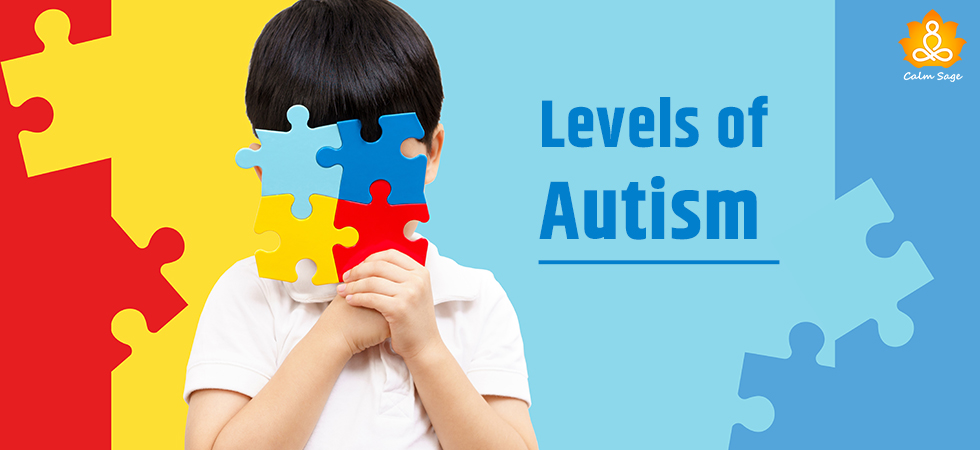What are The Three Levels of Autism? Understanding Them in Detail

In 2013 when DSM-5 was published and a major change in how children with autism were diagnosed was made, it created confusion for many. While some concepts are coming to use, certain terminologies are still confusing. One such change was switching from high vs. low functioning autism to the three levels of autism.
Many people still use the previous categorization to understand and cater to a person’s needs. However, the new spectrum is completely different and it’s time we replace it with the classic one. To begin with, let us understand each of these levels in detail!

The Three Levels of Autism
The three levels of autism are based on different factors like a person’s strengths, limitations, ability to communicate, the need for support, ability to adapt to situations, and skills to manage daily life. According to DSM-5, these levels help to identify the severity of symptoms in two major domains viz., social skills and restrictive or repetitive behavior.
LEVEL 1: Requiring Support
- They require help to navigate through their life.
- It is the mildest level of ASD wherein the symptoms of autism do not interfere too much with different areas of life.
LEVEL 2: Requiring Substantial Support
- They need help in handling everyday life challenges.
- People with levels require support in the form of social skills training, vocational therapy, and speech therapy.
LEVEL 3: Requiring Very Substantial Support
- They often need one-on-one support.
- This is the most severe form of autism. They often require full-time aid and intensive therapy.
Anyone who is diagnosed with Autism Spectrum Disorder (ASD) is further diagnosed as having ASD level 1, 2, or 3.
Remember: These levels aren’t clear-cut or permanent. Different factors like environment, stress, therapy, and more impact the person’s ability to function.
Understanding The Three Levels of Autism in Detail
| LEVEL 1: REQUIRING SUPPORT | |||
Social Communication |
Restriction & Repetitive Behaviours |
Other Traits |
Points Not To Miss On |
| Difficulty initiating social interactions or responding to the same. | Difficulty switching between activities. | They appear to be socially awkward. | They face some challenges in social interactions. So offer them help. |
| Fails to have to-and-fro conversation with others. | Problem in organizing and planning things. | Their developmental delays are often considered as signs of laziness. | Meeting the expectations of society can be a little exhausting for them. Be patient. |
| Difficulty making new friends. | “Love Hormone” | They can adapt to changes but they still prefer routine. | Understand their efforts and offer them respect. |
| LEVEL 2: REQUIRING SUBSTANTIAL SUPPORT | |||
Social Communication |
Restriction & Repetitive Behaviours |
Other Traits |
Points Not To Miss On |
| Limited social interactions and reduced responses to others. | Inflexibility and difficulty coping with the changes of life. | Social life is limited. | They are paying attention to you and trying to understand you. Give them some time. |
| Odd nonverbal communication that is apparent even with the supports. | Frequent repetitive and restricted behaviours. | Coping with changes in routine is very difficult for them. | They need support, help and respect to cope with stress. |
| Marked deficits in verbal and nonverbal social communication skills. | Difficulty changing focus or attention. | Due to significant developmental delays they achieve the milestones pretty late. | Routine helps them feel safe, try to understand them. |
| LEVEL 3: REQUIRING VERY SUBSTANTIAL SUPPORT | |||
Social Communication |
Restriction & Repetitive Behaviours |
Other Traits |
Points Not To Miss On |
| Limited initiation of conversation and minimal responses. | Extreme difficulty in coping with changes. | The restrictions and health conditions are obvious. They might just interact to express basic needs. | They might seem responsive but they take time to hear and understand you. So be patient. |
| Responds to only very personal and direct social approaches. | Repetitive and restricted behaviours markedly interfere with daily life functioning. | The intense repetitive behaviours are calming and important to them. | Routine helps them feel safe. Let them have it in their life. |
| Makes unusual approaches to respond to others minimally. | Great distress in changing attention or focus. | Due to developmental delays they might be able to meet every milestone. | They need help with communication skills so offer them support |
Image source: Quora
Limitations of ASD LEVELS
The new update in DSM-5, that is, the Three Levels of Autism is definitely helpful in understanding the signs of a person. However, it fails in explaining the severity of these symptoms distinctively. Along with this, no specification on the type of support that a particular level of ASD might need is provided.
For example, an autistic child may perform well at home but might need social support at public gatherings. Plus, no recommendations on shifting the levels after developing certain skills over time is advised. Ultimately leaving us questioning the new spectrum: the three levels of ASD.
To conclude I will say that just like the classic classification of the autism spectrum, this categorization to has some loopholes. However, it does help in understanding the severity of symptoms of autism experienced by a person, need of support, and aids us in serving them best. So make sure that you are using these levels only to understand their special needs that you can offer them and not as labels.
If you found this information useful, share it with a friend of yours, and don’t forget to share your feedback in the comments section below.
Thank you for reading!





















